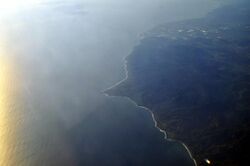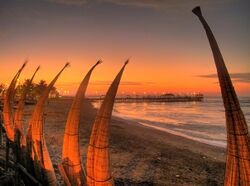World Surfing Reserves
Topic: Organization
 From HandWiki - Reading time: 5 min
From HandWiki - Reading time: 5 min
World Surfing Reserves (WSR) is a program launched in 2009 by the non-governmental organization Save the Waves Coalition aimed at protecting global surf habitats. The program proactively identifies, designates and enshrines international waves, surf zones and surrounding environments, protecting them from the threat of development.[1][2]
History
The idea to protect surf spots originally came from to one of the cofounders of the program, the National Surfing Reserves (NSR) in Australia. After four years of naming surf spots in Australia, NSR partnered with the NGO Save the Waves Coalition and launched the World Surfing Reserves to go international with their protection program. Professional big-wave surfer Joao de Macedo is also a co-founder of the program. It was officially launched at the Value of Waves Roundtable held in Half Moon Bay, California .[3]
Locations
There are currently twelve surfing reserves across the world.[4] World Surfing Reserves are nominated through a selection process and there are currently dozens of proposed WSRs covering nearly every continent on the planet. The dates indicated the commencement of the commitment by the local and international communities to protect and preserve Malibu as an iconic surf site.
| Nb | Country | Location | Since | Note |
|---|---|---|---|---|
| 1 | USA | Malibu Surfrider Beach | 9 October 2010 | 1st World Surfing Reserve site.[5] |
| 2 | Portugal | Ericeira | 14 October 2011[6] | 4 km stretch, 7 surf spots (including Ribeira d’Ilhas and Coxos), recognized for its high density of surf breaks, wave quality, and unique environment.[7] |
| 3 | Australia | Freshwater Beach | 10 March 2012 | 4 km stretch, declared the "Manly-Freshwater World Surfing Reserve", inaugurated by Kelly Slater and Marie Bashir (governor of New South Wales).[8] |
| 4 | USA | Santa Cruz, California | 27–28 April 2012 | Inaugurated by Pat O'Neil (O'Neill wetsuits).[9] |
| 5 | Peru | Huanchaco beach, Trujillo | 26 October 2013[10][11] | The surf spot is famous for the caballitos de totora.[12] |
| 6 | Mexico | Todos Santos Islands | 20 June 2014 | stretch from Salsipuedes to El Sauzal.[13] |
| 8 | Australia | Gold Coast | 8 March 2016 | 16 km stretch from Burleigh to Snapper Rocks.[14] |
| 9 | Brazil | Guarda do Embaú | 28 October 2019 | World-class wave that breaks consistently year-round.[4][15] |
| 10 | Chile | Punta de Lobos | 20 November 2017 | WSR purchased the Mirador Property at the tip of the Punta de Lobos to protect this area.[16] |
| 11 | Australia | Noosa Beach | 20 November 2017 | 4 km stretch[17] |
| 12 | United Kingdom | North Devon | January 2022 | Encompasses 30 km of coastline and includes some outstanding surfing locations like Croyde, Saunton, and Woolacombe.[18] |
Mission
The mission of the World Surfing Reserves (WSR) program is to gain international recognition and support for wave and coastal protection around the world by creating a global network of designated surfing reserves. WSR also recognizes environmental, social, cultural and economic benefits of waves.[19] WSR was created in conjunction with National Surfing Reserves Australia,[20] and has established partnerships with the International Surfing Association (ISA), and Stanford University's Center for Responsible Travel (CREST).[21] WSR is also affiliated with the Surf Conservation Partnership led by Conservation International.[22]
In August 2009, WSR called for nominations from all national surfing federations.[23] More than 150 sites were nominated from 34 countries. WSR eventually plans to induct 30-40 surf breaks around the world. The program has gained a substantial amount of positive feedback and support from the sport's leaders, including Kelly Slater.[24]
Council and committee
World Surfing Reserves is led by an international executive committee and vision council. It is the responsibility of these groups to govern the program and make the final wave selections. For a specific surf site to enter WSR, the region must have exceptional and consistent surf, along with a rich history and culture of surfing, as well as strong community support.
Vision Council
Fernando Aguerre, Will Henry, Jim Moriarty, Tony Butt, Terry Gibson, Len Materman, Miles Walsh, Wallace J. Nichols, Steve Hawk, Wayne “Rabbit” Bartholomew, Tiago Pires, Greg Long, Mark Massara, Chris LaFrankie, Chad Nelsen, Neil Lazarow, Brad Farmer, Manolo Lozano, Juca De Barros, Drew Kampion, Professor Andy Short, Professor Ben Finney.
Executive Committee
Professor Andy Short, Brad Farmer, Drew Kampion, Will Henry, Dean LaTourrette.[25]
Google Earth Plug-In
Save the Waves Coalition also created a Google Earth WSR plug-in[26] that allows organizations and individuals to view nominated sites around the world. The plug-in allows users to learn about a nominated wave's history, location, environmental characteristics and surf culture.[27]
See also
- Huanchaco
- Trujillo
- Malibu Lagoon State Beach
References
- ↑ "Save The Waves Coalition Website, World Surfing Reserves Home Page". http://www.savethewaves.org/world_surfing_reserves.
- ↑ "How Are World Surfing Reserves Created?". http://thelens.surfstitch.com/2015/12/21/how-are-world-surfing-reserves-created/. Retrieved 17 May 2016.
- ↑ "Save The Waves Coalition : Value of Waves Roundtable". http://www.savethewaves.org/news/view/56/.
- ↑ 4.0 4.1 "World Surfing Reserves". https://www.savethewaves.org/wsr/.
- ↑ "July 22, 2010, "Malibu World Surfing Reserve" World Surfing Reserves Nomination". http://www.savethewaves.org/news/malibu-world-surfing-reserve.
- ↑ "Ericeira Rides to World Surfing Reserve Fame". http://www.worldsurfingreserves.org/ericeira-rides-world-surfing-reserve-fame. Retrieved 31 January 2015.
- ↑ "How Portugal's big waves are boosting the economy". 6 January 2015. http://lifestyle.inquirer.net/181581/how-portugals-big-waves-are-boosting-the-economy. Retrieved 31 January 2015.
- ↑ "Kelly Slater Helps Launch Australian WSR". World Surfing Reserves. 2012-03-10. http://www.worldsurfingreserves.org/surfing-legend-kelly-slater-launches-aus-wsr. Retrieved 2012-03-11.
- ↑ "Santa Cruz Formally Dedicated". http://www.savethewaves.org/news/santa-cruz-formally-dedicated. Retrieved 6 February 2015.
- ↑ "Huanchaco-World Surfing Reserve in Peru". http://www.savethewaves.org/news/world-surfing-reserve-in-peru. Retrieved 3 October 2012.
- ↑ "Huanchaco Dedicated as 5th WSR". http://www.savethewaves.org/news/huanchaco-dedicated-as-5th-wsr. Retrieved 6 February 2015.
- ↑ http://www.munihuanchaco.gob.pe/historia.php Huanchaco history
- ↑ Replogle, Jill (20 June 2014). "Baja California's Todos Santos Designated World Surfing Reserve" (in en). https://www.kpbs.org/news/2014/jun/20/baja-californias-todos-santos-designated-world-sur/.
- ↑ Lieu, Johnny (9 March 2016). "Australia's Gold Coast is officially the eighth World Surfing Reserve" (in en). https://mashable.com/2016/03/08/gold-coast-surfing-reserve/.
- ↑ "Brazil's Guarda do Embaú Officially Dedicated the 9th World Surfing Reserve" (in en-US). 2019-10-29. https://www.mensjournal.com/adventure/brazils-guarda-do-embau-world-surfing-reserve/.
- ↑ "Punta de Lobos and Noosa declared World Surfing Reserves" (in en-us). https://www.surfertoday.com/surfing/punta-de-lobos-and-noosa-declared-world-surfing-reserves.
- ↑ Shorthouse, Janel; Skinner, Jo (2017-11-17). "Noosa's surf breaks declared World Surfing Reserve" (in en-AU). https://www.abc.net.au/news/2017-11-17/noosa-surf-breaks-declared-world-surfing-reserve/9161904.
- ↑ https://www.savethewaves.org/north-devon/
- ↑ "World Surfing Reserves – NRS National Surfing Reserves". https://www.surfingreserves.org/world-reserves/.
- ↑ "NRS National Surfing Reserves". https://www.surfingreserves.org/.
- ↑ "Center for Responsible Travel | Transforming the Way the World Travels". https://www.responsibletravel.org/.
- ↑ "The Surf Conservation Partnership" (in en). https://www.conservation.org/priorities/the-surf-conservation-partnership.
- ↑ "Save The Waves Coalition, World Surfing Reserves Nominations". http://www.savethewaves.org/news/view/93.
- ↑ March 15, 2010, Surfer Magazine, "Kelly Slater Joins WSR Movement"
- ↑ "Save The Waves Coalition Website, World Surfing Reserves Home Page". http://www.savethewaves.org/world_surfing_reserves/.
- ↑ "Save The Waves Coalition : World Surfing Reserves/Google Earth". http://www.savethewaves.org/news/view/91/.
- ↑ "World Surfing Reserves, Google Earth Plug-In". http://www.savethewaves.org/news/view/91.
Further reading
- Vanessa Ratten, Social innovation in sport: the creation of Santa Cruz as a world surfing reserve, International Journal of Innovation Science, 26 March 2019 (ISSN 1757-2223)
External links
 |
 KSF
KSF


